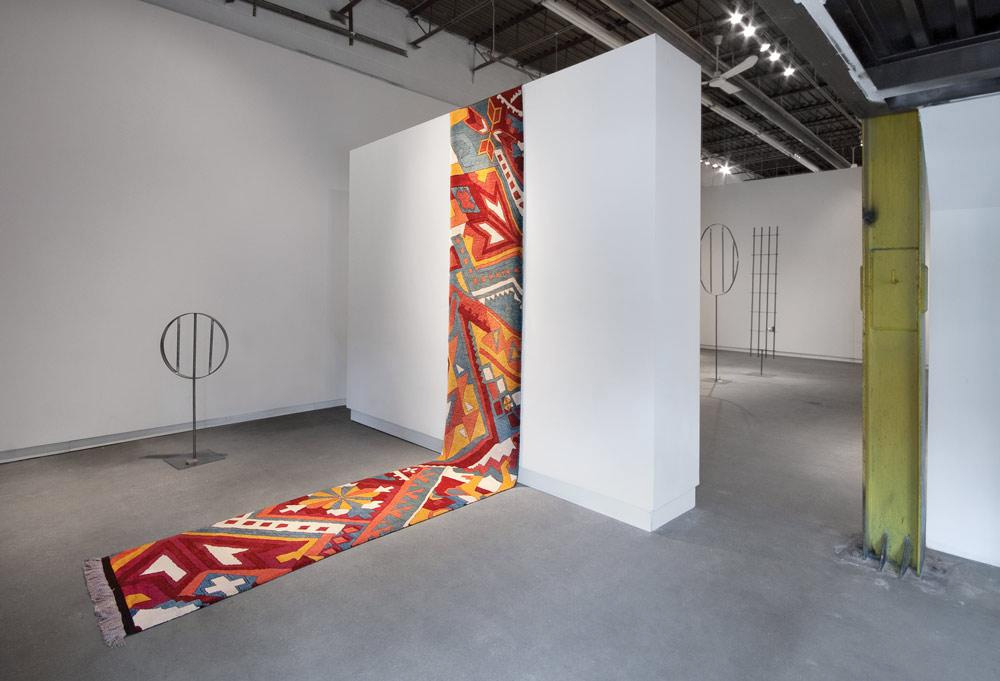
Installation view of Shannon Bool's "Patterns of Emanipation" with Casino Runner (Aztec Inn) (2011)
Courtesy Daniel Faria Gallery
Surface Matters
Shannon Bool Brings Ornament into the 21st Century.
—
“Decoration is psychologically charged,” says Shannon Bool, the British Columbia–born, Berlin-based painter, muralist, sculptor and photomonteur. She is talking to me from the hills of Florence, where she is in residence as this year’s winner of the Villa Romana Fellowship, a German art prize whose past recipients have included Käthe Kollwitz and Georg Baselitz.
While still new to showing in Canada, Bool has made waves in Europe. Charles Saatchi, the Berlinische Galerie, the Museum für Moderne Kunst and the Lenbachhaus collect her work, which draws on psychology, popular culture and art history, and brings together such odd bedfellows as Barnett Newman and Pamela Anderson. Last summer, Bool was also part of “Made in Germany Zwei,” an exhibition in Hanover that featured 40 rising international artists currently working in Germany.
Bool’s path to success can be traced back to her introduction nearly a decade ago to one of Europe’s most controversial aesthetic polemics: the relevance of decoration. Ignited in 1908 by the early Modernist Austro-Hungarian architect Adolf Loos with his essay “Ornament and Crime,” which equated elimination of ornament with cultural progress, the debate shaped a century of art. “In curatorial circles, it became popular to view artists who worked with ornament as anti-Loos,” says Bool. “But Loos was reacting to the aesthetic politics of Vienna at the time. He was totally neurotic about the exterior of things. He was specific about the kinds of marble he used and the veneers he chose—all things that form ornamental pattern. He would even curate the carpet collections of his clients.”
Drawing on Loos and other early 20th-century art theory, Bool found the underlying theme of her work: the psychology of surface and how it can be used for emotional effect. “In the contemporary art world, this idea is passed over too often,” she says.
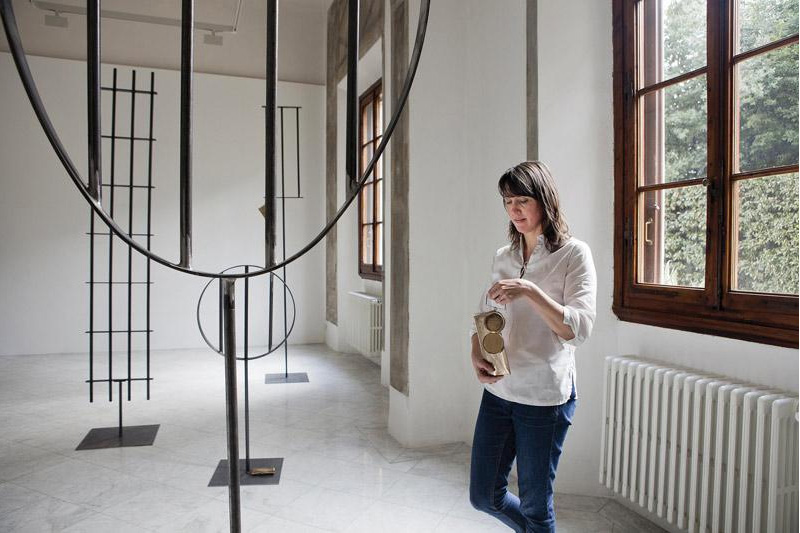
Shannon Bool with works from her Gitterskulpturen series (2012) in the exhibition hall of Villa Romana, Florence, Italy, April 2013.
Photo Giulia Del Piero
The last thing Bool imagined growing up in Comox, on Vancouver Island, was that she would be making art linked to one of Modernism’s great theorists. As the youngest child of working-class parents (her father is an oil delivery man, her mother a legal secretary), “art wasn’t something I equated with being successful in life,” she says.
Then again, there were signs of what lay ahead. In Grade Six, after a class project that involved making Ukrainian Easter eggs, Bool headed to a craft store, bought a kistka (the stylus used to create the eggs’ elaborate, repetitive decoration) and “obsessively made them for months.” While completing a BA in literature with a minor in psychology at the University of Victoria, she took life-drawing and watercolour classes. In her final year, she enrolled in an elective art-history course, and it was enough to make her consider a career as an art therapist, a job where she could draw on her experience of working summers in Comox with children with disabilities.
After graduation, Bool moved to Vancouver and took a position as a youth and family worker with the New Westminster school district. In 1998, she began night classes at Emily Carr Institute of Art and Design, prerequisites for admission into an art-therapy program. But, after one semester, she changed her plan: “I knew that I wanted to be an artist,” she remembers. “I had to quit my day job to go to school full time.”
After a year of study at Emily Carr, Bool went on exchange for one semester to New York’s Cooper Union School of Art, where she became friends with a German artist. “When she offered me her Frankfurt studio, I went,” says Bool. “I had never been to Europe.”
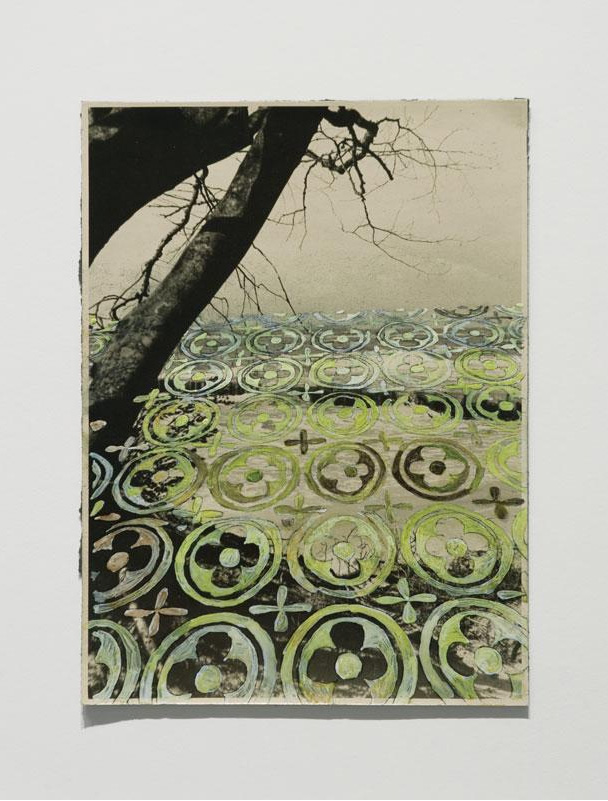
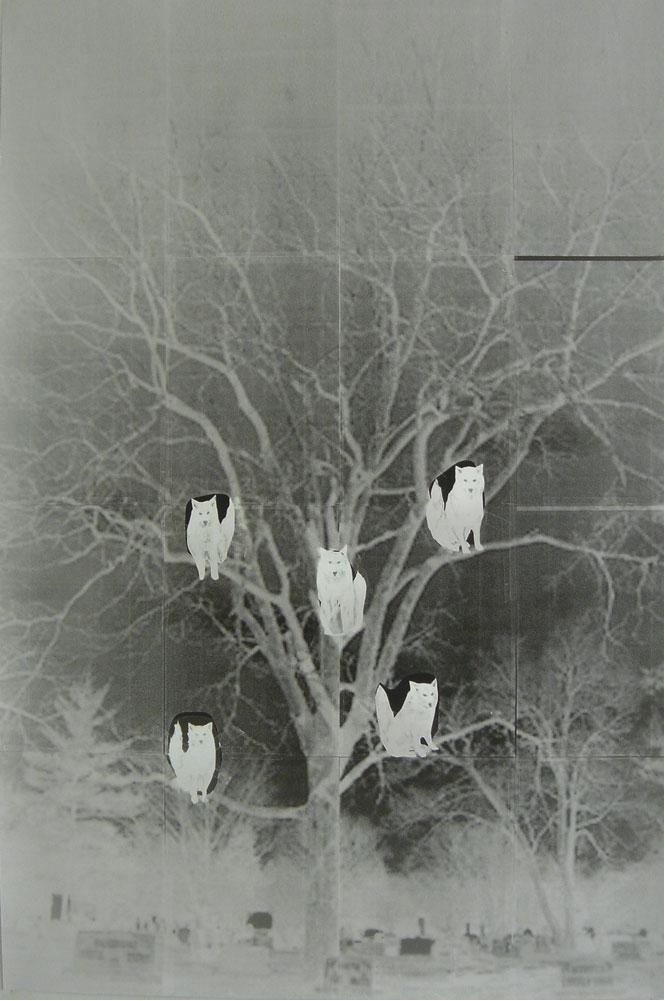
Left: Installation view of Shannon Bool's "Patterns of Emanipation" with Casino Runner (Aztec Inn) (2011)
Courtesy Daniel Faria Gallery
Right: Shannon Bool 6 or 7 wolves (cut out version) 2005 Photogram 1.58 x 1.11m
Courtesy Galerie Kadel Willboarn, Karlsruhe / Dusseldorf
Once there, Bool discovered that she was living across the street from the Städelschule, one of Germany’s most prestigious art schools. After a couple months, she looked out the window and thought, “If I become a student there, I can stay in Europe longer.” Bool began taking undergraduate classes and eventually completed her Meisterschule (the German equivalent of a Master’s) in 2004.
Bool’s first big break came in 2003, during her second year at the Städelschule. Her art caught the eye of its principal, Daniel Birnbaum, now director of the Moderna Museet in Stockholm, and he recommended it to Phaidon’s publishers, who were assembling Vitamin D: New Perspectives in Drawing (2005), a global survey on drawing that featured 109 emerging artists in the field. When the New York Times reviewed the book, its lead image was Fired from Walmart (2004), an ink-and-acrylic drawing by Bool.
The work features a mariachi guitar player, copied from a flamenco instructional manual that Bool found at a Frankfurt bazaar, who is drawn on an ornate, spiral-decorated book lining, also found at a market. These features combine to create a collage of disparate elements with an autobiographical subtext: a key feature of Bool’s work.
“I made the drawing when I was feeling like a stranger in a very bohemian, very decadent scene,” says Bool. At the Städelschule, she was working in a studio belonging to Hermann Nitsch, the Austrian performance artist known for his ritualistic works—famously, the display of a skinned and mutilated lamb. “It was an overwhelming environment. I didn’t feel comfortable being avant-garde and doing a performance,” says Bool. Her title for the drawing came while she was thinking about “how low you can go.”
Bool may have felt like an outsider, but her art tapped in. In 2003, she had a solo show at the Frankfurter Kunstverein curated by René Zechlin, who wrote about Bool’s art, linking it to Adolf Loos. “He made me start thinking about ornament in a conscious way,” says Bool. The Kunstverein exhibition yielded another important result: representation by the Karlsruhe-based gallerist Iris Kadel, who has been Bool’s main dealer since 2004, and who facilitated her inclusion in “Liquid Soft Lightning Touch” at Edinburgh’s now-defunct Doggerfisher Gallery.
Still a student, Bool was making regular visits to the Städel Museum, one of Frankfurt’s most important collections of historical art, where a repeated feature of Northern Renaissance Madonna-and-child paintings caught her attention. “They often included rich Oriental carpet set in a dramatic non-linear perspective—a device that tipped you into the painting,” says Bool. To figure out what she was looking at, Bool started reading German art historian Erwin Panofsky, whose theory of schraegraum offered an answer. “In 15th-century Northern Renaissance paintings, ornamental carpets were not simply surface decoration,” says Bool. “They were frameworks of perspective, components of a spatial architecture.”
This realization inspired Bool’s Origin/Inversion (2005), an elaborate pencil-and-gouache wall-mural installation created for the Doggerfisher exhibition. The work brings together two carpet images, each offering a separate take on perspective, each sourced from a historic Madonna-and-child painting—one by Jan van Eyck, the other by Hans Memling—drawn at more than two and a half metres tall on adjacent walls. By taking these elements out of their original contexts, Bool offered a fresh reading on the role of decoration, time and space. She placed a quarter-disk made of wood laminate below the work, resting on the floor, “to add to its atmospheric quality.”
In 2005, Bool moved to Berlin, along with Dani Gal, an Israeli artist, who she met at the Städelschule and who is now her husband. “It was a logical midpoint between both our families,” she says, “and where artists from everywhere seemed to be moving.”
Bool began creating photograms, a medium she had first explored in Frankfurt. The work 6 or 7 wolves (2005) is based on a drawing of a dream by one of Sigmund Freud’s most famous patients, Russian nobleman Sergei Pankejeff (whose treatment played a role in Freud’s theory of psychosexual development). When Bool saw an image that Pankejeff drafted of white wolves sitting on walnut-tree branches, it became the inspiration for a black-and-white collage she made by placing found photos of leafless walnut trees and her own drawing of wolves on photo-sensitive paper. Together, these elements create a haunting image in which decorative details become the basis of what Bool would later describe as a “psychological space.”
Painting on silk, another new technique, entered Bool’s repertoire at the same time. When she was asked to participate in the “Art Statements” section of Art Basel in 2006, Bool decided to create a portrait of Melanie Klein, the famous pioneer of child analysis. To communicate “that unreachable realm, always part of psychoanalysis,” Bool painted Mrs. Klein at the Window (2006) on a sheet of silk. She then mounted the portrait on glass to give it a window-like feel. The technique offers a unique effect: when rays shine through the ethereal and hauntingly beautiful work, it conveys an enigmatic sense of space as light reflects back through its glass.
At first, Bool was shy about making silk paintings. “Their beauty is seductive,” she says. “I was worried that I might not want to make anything else.” Her instincts about their allure were bang on. In 2007, she showed three silks at London’s Herald Street Gallery. When Charles Saatchi set his eyes on them, he bought them all.
The Toronto gallerist Daniel Faria approached Bool to represent her after seeing her work at Art Basel Miami in 2010. In the summer of 2012, he mounted “Patterns of Emancipation,” Bool’s first Canadian solo show. It included sculpture, the most recent aspect of her practice.
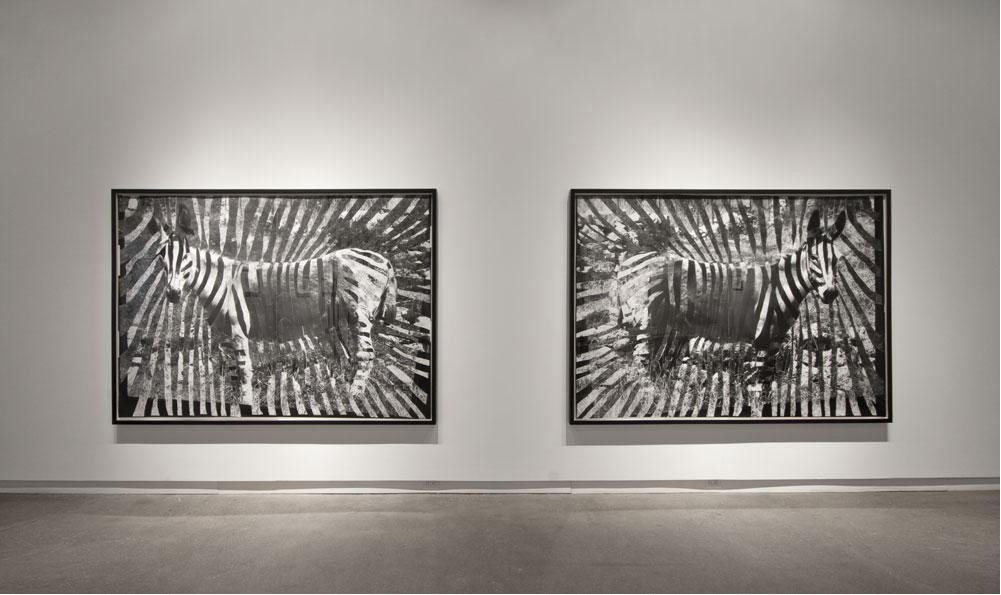
Shannon Bool Gaza Zebra 2012 Diptych photogram 1.54 x 2.17 m each
Courtesy Daniel Faria Gallery / Galerie Kadel Willborn, Karisruhe / Dusseldrof
Shannon Bool Gaza Zebra 2012 Diptych photogram 1.54 x 2.17 m each.
Courtesy Daniel Faria Gallery / Galerie Kadel Willborn, Karisruhe / Dusseldrof
Grounding the exhibition was Casino Runner (Aztec Inn) (2011), a six-metre-long carpet draped over a wall at the front of the gallery. Bool appropriated its pattern from the floor covering of an Aztec-themed hotel in Las Vegas. The piece is a continuation of a body of work Bool began in 2007, when she first gave three-dimensional form to the 15th-century Northern Renaissance carpets she had been drawing. In Anatolia, Turkey, Bool found a workshop that would weave rugs based on her perspective-skewed images. The works are about the ornamental role of perspective, as well as the dissociation of decoration from its source. She warns, “Today you can’t take decoration at face value.”
With Gaza Zebras (2012), also in the show, Bool advanced this point. She created the oversized photogram diptych after hearing about a strange incident at Gaza City’s Marah Land Zoo in 2009. When two zebras died of hunger during the Gaza War, the zookeeper replaced them with donkeys whose hides he deftly disguised with masking tape and black hair dye.
Furthering these overlapping themes of ornament and imprisonment, the show also included Gitterskulpturen (2012), steel-cut forms made in the shape of windows at the Pankow district site of the Berlin Women’s Prison. The work grew out of a two-year project that Bool initiated, where she conceived and executed an expansive decorative wall mural with the voluntary assistance of female inmates, bringing them special breakfasts—of organic bread, smoked salmon and real coffee—in return for their help. (“Germany is open to this sort of thing,” she says. “People do theatre and other kinds of art in prison.”) At the heart of the mural was the idea of the decontextualization of decoration. “It’s the sort of work that would traditionally be made for very public spaces like museums or churches,” says Bool. “But here, it’s created for an area you can see only as a prisoner.”
For Gitterskulpturen, Bool cast in bronze 24 items representing the prized personal possessions of the prisoners who assisted her—including lighters, cosmetics, envelopes and chocolates—and fixed them to the bars of her sculpture, where they take on the look of charms. “It is a work that is elegant and empathetic,” says Faria, “and one that transcends our notion of formalism.” Gitterskulpturen is also a riff on a series of bar sculptures about symbolism and ornament that Bool began making in 2008, which includes Broken Pole(2010). The work references Barnett Newman’s three-ton steel sculpture Broken Obelisk(1963–69) as well as stripper poles, whose iconography began to interest Bool after she learned that the Hollywood star Pamela Anderson had decorated her living room with one.
With Lindsay (2012), Bool offered up another montage of high and low culture. It features Lindsay Lohan’s lips, painted on a black-and-white found photo of a beach. “I wanted to localize this pouting gesture—another form of decoration—that I kept seeing in celebrity magazines,” says Bool, “and combine it with the fact that the horizon has always been an art-historical reference of projection.” Like her works that grew out of the prison in Pankow, Lindsay is also a commentary on ornament and unobtainable longing.
Although her work has not yet been collected by a public Canadian institution, Bool has a busy Canadian itinerary of exhibitions. This summer, “Screen and Décor,” a travelling group show, opens at Toronto’s Justina M. Barnicke Gallery, then moves to Lethbridge’s Southern Alberta Art Gallery in the fall. According to Faria, there is little doubt that Bool will soon become a name known here, as well as in Europe. “For the last decade, Shannon has consistently been doing her own unique thing,” he says, “and things have consistently fallen into place for her. She won’t be off the radar here for long.”